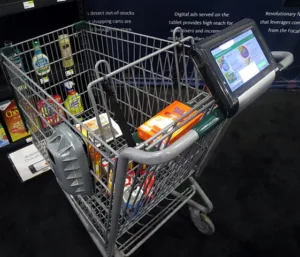The Innovation Lab (IL) was on the top level of the Javits convention center and was dedicated to startups and other small companies with breakthrough technologies for retail. That level has huge windows on three sides. While this provided glorious views of Manhattan and the Hudson River, on a sunny day it is not a good place to demonstrate the innovative display technology and applications shown by many of the IL exhibitors. The Startup Pavilion was an area on the main exhibit floor set aside for startup companies.
The IL and Startup pavilion had so many interesting vendors, I’ve broken this into two sections. This first one deals with robots and machine vision for aisle inspection. The other section will deal with customer-oriented display technology. (NRF: The Innovation Lab & Startup Pavilion II: Displays)
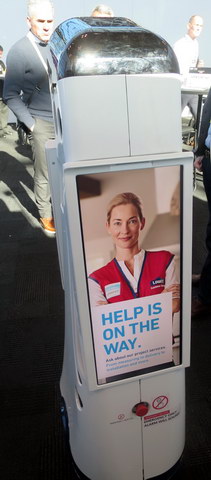 Navii robot for inventory control and customer assistance. (Credit: M. Brennesholtz)
Navii robot for inventory control and customer assistance. (Credit: M. Brennesholtz)
Fellow Robots was showing its Navii robot, which has been in Lowes stores for about three years and has been exhibited at NRF before. The robot can navigate around the floor of a retail store independently, and avoid, not only fixed obstacles such as the store’s installed shelves, but also mobile and temporary obstacles such as the store’s customers or temporary display cases set up in aisles. The robot has two main functions, inventory control and customer interaction.
There are several facets to the inventory control function. First, it can scan the shelves with its vision system and detect out of place items on the shelves. It has no ability to pick these items up and return them to where they belong, but it will report them to the store management, who can then provide a list to an employee about all out of place items in the store. Second, it can detect out of stock items and report them to the manager. Finally, it can detect mis-priced items where the shelf edge label does not match the price of the indicated item.
The second main function is customer interaction via touch screen displays on its front and rear. These displays can help a customer identify what he wants and then show a map of where the item is in the store although the robot will not lead the customer there. Currently, the robot will only interact with the customer through the touch-screen display – there is no voice interactivity. According to the Fellow Robots rep, normally the Navii robot is programmed on a given day for either inventory control or customer interaction and the customer cannot interrupt the robot to ask questions while it is set for inventory duties.
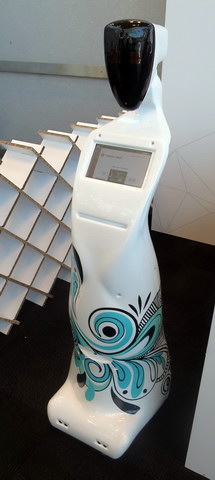 Robot in the Inspector Cloud booth (Credit: M. Brennesholtz)
Robot in the Inspector Cloud booth (Credit: M. Brennesholtz)
Inspector Cloud is based in Russia and is primarily an image recognition company, not a robot company, according to CEO Alexander Berenov. Like Fellow Robots, its system can identify empty shelves, misplaced products, incorrect shelf-edge labels etc. Berenov says that the company’s machine learning algorithms mean that it can learn to identify new products in very short times.
Shopping cart equipped with a Focal aisle-scanning camera (grey box on left) and a Focal tablet. (Credit: M. Brennesholtz)
Focal Systems, in the Startup Pavilion, had a different approach to the problem addressed by Fellow Robots and Inspector Cloud. Instead of mounting their cameras to scan the aisles on mobile robots, they mounted them on the normal shopping carts. As shopping carts, pushed by customers, weave a random pattern through a grocery store, there is almost always a cart going down every aisle. Kathy Mak, Focal VP of marketing, said that if one cart in ten was equipped with an aisle scanning camera, that normally provided sufficient coverage for the store manager to have near-real time data on out-of-stock issues and misplaced items for the entire store.
Focal was also demonstrating a tablet to be mounted on the handle of a shopping cart. This unit was dual-function. First it provided the customer with desired information such as the location of a desired product in the store. The focal technology is said to be able to track the shopping cart location to within 1 foot (30 cm) inside the store, certainly sufficient for store navigation. The tablet could also offer the customers special deals and provide advertisements.
Second, the table feeds back data to store management, as input to an analytics system. This would include where the cart went and where inside the store it paused while the customer shopped. Focal is also developing an auto-checkout system, “Just throw it in the cart,” where two cameras on the front and rear of the cart would monitor the cart contents and avoid the need for the customer to go through a regular checkout aisle. This system was not being demonstrated at the NRF.
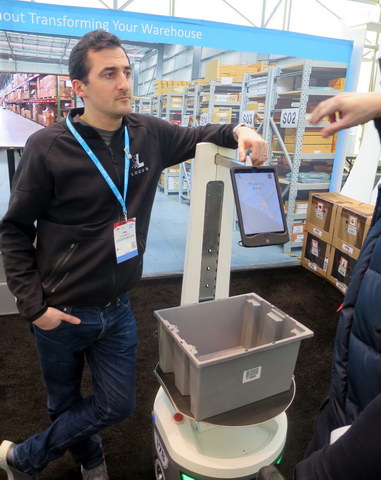 An autonomous robot from Locus said to increase the picking efficiency of warehouse employees. (Credit: M. Brennesholtz)
An autonomous robot from Locus said to increase the picking efficiency of warehouse employees. (Credit: M. Brennesholtz)
Locus Robotics is a manufacturer of robots designed for warehouse use. The robot dispatcher will load a list of items to be picked for a consumer order into the iPad mounted on the robot. Locus says that its software will interface seamlessly with any Warehouse Management Systems (WMS) software. The robot will then autonomously navigate to the pick stations where the items can be found, avoiding obstacles such as other robots, people, warehouse shelving and forklift trucks. The software and sensors that enable this autonomous motion are simplified versions of the systems that run self-driving cars. A human employee at each pick station then sees what is needed from his station on the iPad touch screen, picks the needed item(s) from his station, puts them in the robot’s bin and signals to the robot that he has picked everything from that station. If there are more items on the robot’s pick list, it goes to the next station, otherwise it goes to a packing and shipping station with its load. The robotic system can also support having a robot pick two or more orders simultaneously. In this case, color coded bins are used (red, blue, green, etc.) and the robot indicates which color bin the human should place a picked item.
The robot, called LocusBot, weights100 lbs (36kg) (unloaded), can carry a payload of 40 – 100 lbs (18 – 45kg) and has a travel speed of 2 m/s. The LocusBot will operate for 10 hours/charge, has a recharge time of 30 – 60 minutes and will recharge from either 110 or 220V power.
The Locus representative said that by having humans at fixed stations and the robots mobile, warehouse productivity is increased by a factor of 2x – 4x. Locus does not sell the robots but provides them as Robots as a Service (RaaS) for about $1,000/month/robot. Even only a 2x productivity improvement would make this cost effective, even in warehouses that use minimum-wage employees, since even these low-paid employees cost more than $1,000/month. A 4x productivity increase would represent a dramatic reduction in warehouse picking costs.
Another advantage of the Locus system is that humans continue to pick the items so there is no need for the warehouse to be completely rearranged to enable robots to do the actual picking.
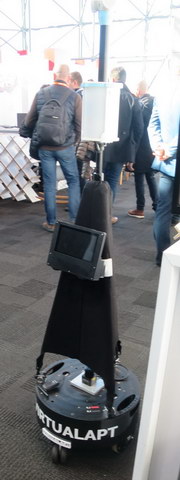 VirtualAPT robot for making 360° videos. The three camera array is at the top of the boom, at about eye level. (Credit: M. Brennesholtz)
VirtualAPT robot for making 360° videos. The three camera array is at the top of the boom, at about eye level. (Credit: M. Brennesholtz)
I talked to Bryan Colin, co-founder and CEO of VirtualAPT. His company has built a robot to make walk-through 360° videos for a variety of applications including retail stores and real estate. VirtualAPT then takes the raw video edits it, adds tags to various products seen in the video and lets the store post it on their website. At the 360° video nadir, the robot is hidden by VirtualAPT by inserting the store’s logo. Colin provided me with two links to videos his company has made, for Schott NYC and Eye Hunee. (On my Windows 7 laptop, neither video ran correctly. Maybe they work better from an iPhone. There are also several videos on the VirtualAPT website and they don’t run correctly either when left at the default setting of 4K. Switching the resolution to 480p allows the videos to run correctly, but the resolution is very poor.)

